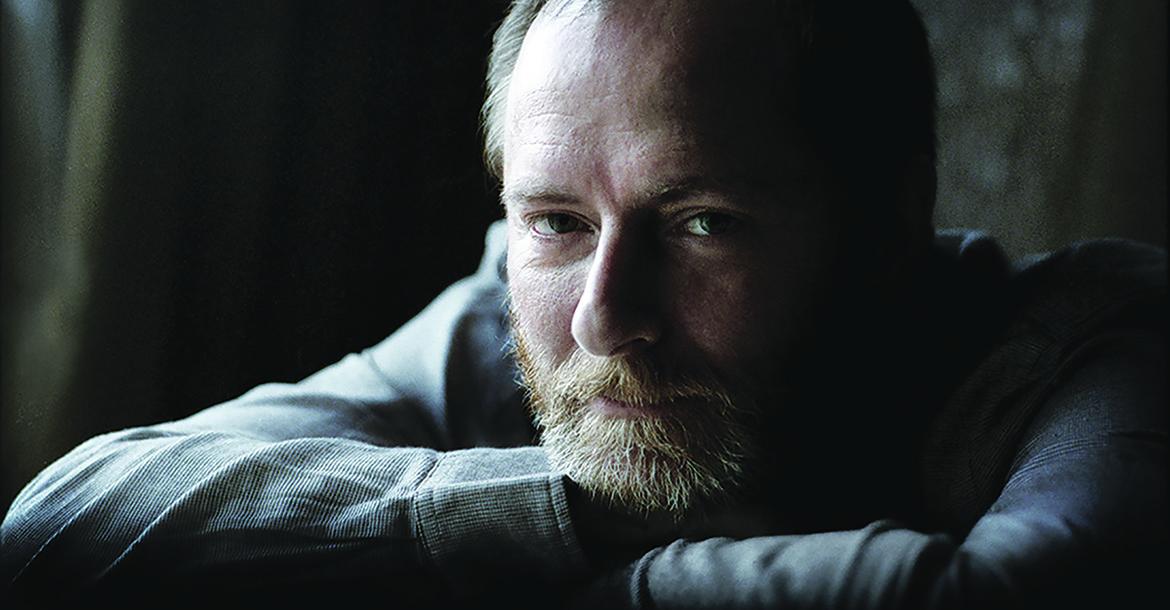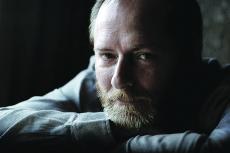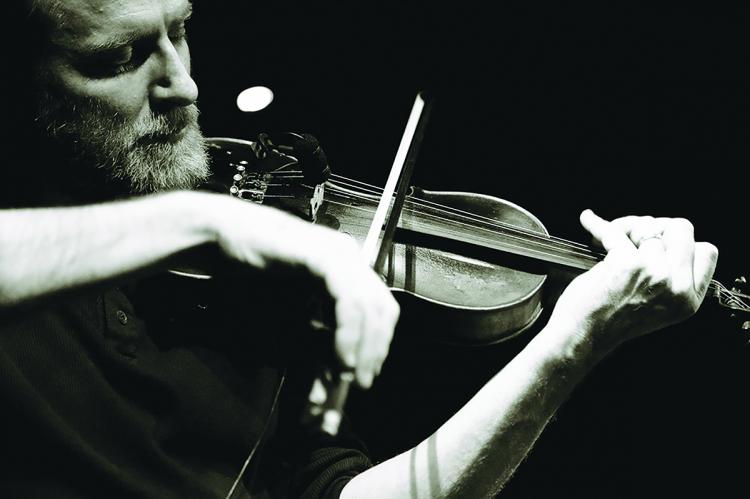Ben Paley
Ben’s father was Tom Paley, founder member of the New Lost City Ramblers. His mother is Claudia Gould, a fine singer with a deep involvement in folk music. His stepfather, Ron Gould, a guitarist and a prominent skiffler. So Ben grew up hearing a wide variety of very interesting music. He wanted to take up the fiddle from the age of six, and was given strong encouragement.
Ben’s father was Tom Paley, founder member of the New Lost City Ramblers. His mother is Claudia Gould, a fine singer with a deep involvement in folk music. His stepfather, Ron Gould, is a guitarist and was a prominent skiffler with a very great and wide knowledge of a whole range of music, particularly jazz and folk music. So Ben grew up hearing a wide variety of very interesting music. He wanted to take up the fiddle from the age of six, and was given strong encouragement. He did not think of life as a performer until he was in his early 20s.
He dropped out of Polytechnic, came to Brighton where he quickly met the guitarist Tab Hunter, and started busking with him having great fun. In the biography section of a book of tunes put together by Ben (which we will come to later), it says that he has played on “street corners of two continents, from Canada to the Deep South, from Lapland to the Mediterranean.”
Ben travelled with Tab, busked on the continent and they played together in a couple of bands in England. The band with Tab that made the biggest impact in those early days was the Wild Turkey Brothers, who became quite a cult band in Sussex. They became the support band of choice when top roots bands played Brighton. They were also booked at quite a number of bluegrass festivals, though Ben thinks that the band divided opinion over their approach: “With some people we went down very well, though others thought us….er…. heretical!” Numerous other musical involvements followed, but rather than list them, let’s mention them as the story unfolds. Firstly, I wanted to ask him about his famed father.
Tom was an iconic figure on both sides of the Atlantic. I must have booked him first around about the time that Ben was born, and I remember vividly his skilful playing and singing at the folk club - I was in awe of him. His knowledge, particularly of the American tradition, made him sound like a walking encyclopaedia. Was Ben aware of this stature when he was a boy?
“It's difficult for me to judge that - he's my dad and I never thought of him as anything other than that. I suppose that it has really been in the last few years that it's been borne in on me just how important he was.” My own feeling is that Tom missed out on awards in the UK, and the recognition that comes with them, for a couple of reasons. I think that it is partly because, though he was an American who spent most of his life living here, he was somehow regarded as an ex-pat, and awards and honours were for Brits. I feel that this is something that is also true for a mutual friend of Ben and mine, Sara Grey. It is perhaps a matter of citizenship. Ben seemed slightly bemused by this suggestion, as if he needed to think about it, but he added that Tom would not have wanted to decide where he lived on that basis.
The other reason I feel that Tom has been undervalued was because of his utterly unassuming manner. He never set himself up to be anything else but an enthusiast, who seemed to enjoy being in the audience as much as performing. All the decades that he lived in that small flat in Islington, if he wasn’t booked that evening, he would often pop out to one of the central London folk clubs and just sit there and enjoy; perhaps offering a Swedish tune or two on his fiddle as a floor spot. Sometimes, when he came down to Brighton to see Ben and Sam and his grandchildren, he would drop into our club in Lewes. He was certainly there the only night when we booked Ben with his mother. Claudia is a remarkable singer with a super repertoire of Appalachian ballads, but she has not really been a public singer with her busy academic career. She had not sung in public for a while until that evening with Ben at the Royal Oak in Lewes, and subsequently she found the Thursday night sessions there a regular conducive setting for her own singing.
A high percentage of Tom’s performances in England were with the New Deal String Band where he played alongside another London-based New Yorker, Joe Locker, and a British fiddler. The first of these for a short time was Bobby Campbell, then Janet Kerr, then Robin Arzonie, but for most of the band’s existence it has been Ben. It would be fair to say that when Tom became London-based and formed the New Deals, the band did a similar job spreading interest and enthusiasm for American oldtime music amongst British and European audiences as his stateside band had for American audiences. They were often featured outside the folk scene and guested on Andy Kershaw's BBC Radio 1 show.
As well as working with the band, Tom was doing a lot of solo work in Britain and on the continent, particularly in Sweden. Back to Ben: “My dad was going back to Sweden for work and the Swedish revival was getting well under way. He was coming back with many albums which he played to me, and that music was so gorgeous and so strange. I spent a lot of time with my ears just stuck in Swedish vinyl. When I was 14, my dad came back from Sweden with armfuls of albums of Swedish fiddle music, and I was amazed and thought, 'I don't understand how this music works, but I'm going to suss it out!' It was just so good, and I started learning so many tunes. I used to go over to Sweden with him and go to the festivals there, hear tunes, meet more people, you know… the sort of things that feed an interest in a traditional music - finding new records and all that sort of thing."
I reminded Ben of his Swedish Fiddle Tune Book and that I had interviewed him about it on the BBC Radio Sussex folk music programme. Neither of us could remember the exact date. “Yes, how old was I? I must have been about 24 when that book came out, and just recently I've republished it. I had been getting emails asking if it was still available and I'd say that I was working on it, so I finally got around to it.”
I had to look it up afterwards and found that it was published in 1993. Could it really be that long ago? This anthology has been the standard work on the subject in English, though it was out of print for many years. This new edition contains the same 53 tunes, hand-drawn and arranged for two instruments by Ben. It was a real labour of love, clear hand-scripted music with beautifully lettered headings and full of interesting, even humorous, notes and illustrations, and a guide to the music and how to play it. The introduction contains a lot of the technical details that fiddle players will find invaluable, and it's all presented in a very clear and accessible way.
I was surprised to find that I still had a recorded copy of the radio interview with Ben (I wish I had kept more of them). He talked about the problems associated with transcribing the idiosyncrasies of the rhythm plus the equally individual tonality and the highly ornamented playing of many of his sources. Ben realised that it was going to be very difficult for The Swedish Fiddle Book to stand alone. The ideal solution seemed to be to produce an accompanying cassette to give musicians who were new to the music an idea of how to move forward from the musical stave to something that sounded like an authentic interpretation of the music. He describes the different rhythms, particularly the fundamental rhythm of Swedish fiddle music which is the polska. A common misapprehension, certainly one that I was guilty of initially, was thinking that this must be what the English and Irish call a polka. Ben said that he hears this all the time.
"Polska certainly means Polish in Swedish. I think that the polska probably started out as a Polish mazurka and as a rhythm it moved north and was taken up in Sweden. It's a three-beat rhythm, but it is distinguished from the waltz in that the beats are not the same length. This makes it incredibly difficult to learn at first until you become familiar with it. The first beat is a bit short, the second is a bit long and hopefully it is all sorted out by the end of the bar, but it is by far the most popular of the Swedish dance rhythms. The dances have a sort of dip in the middle on the long beat as they go around in the circle. It's not easy to describe in words, you need to see it really. That helps you to know how to play it."
Moving on to Ben’s playing career, I said that I remembered him saying in a previous conversation - probably in the car to or from a gig, where most of our conversations have taken place - that in his love life he wanted to be the most faithful man imaginable, but in his musical life he wanted to be a total slut! He would play with anyone! This was a roundabout way of asking him to talk about the range of musicians that he has played with.
After his laughter died down… “Well, I think that it is really important to play all sorts of music; and I have been lucky enough to be able to do that - to play in jazz bands, in traditional folk music bands. I've depped in lots of bands. I've played American music, Swedish, Irish, English music, French and Klezmer - not that I am an expert in all of those things, but I have been able to play them and I feel incredibly lucky to have done so, and I’ve been the guest or session musician on many albums.”
Did he prefer playing live or in the studio? The reply came as quick as a shot from a gun! “Live, without a doubt, for quite a number of reasons. For a variety of reasons too complex to go into here, I find the studio problematic. I'm getting to be more comfortable with studio work, in my 50s, at last!”
The discography on Ben’s website lists around 60 albums recorded between 1991 and the present. They reflect the live appearances and tours that he has made with artists as diverse as Sara Grey, Bonnie Dobson, Dan Donnelly, The Levellers and Jeff Warner. There has also been recording of film scores, with music written by Damon Albarn and Michael Nyman. One of his long-standing but occasional outfits, McDermott’s Two Hours, is a vehicle for the distinctive song writing of Nick Burbridge. His current concert and folk club band is The Long Hill Ramblers, which re-unites him with Tab and features the great singing of Laura Hockenhull. There have been two excellent albums from them, as well as a duo album with Tab which was sold at the very many gigs these two have played together. Another partnership which produced a fine album was with the accordionist Bing Lyle, and Bing, Ben and I are one half of The Sussex Pistols who have been playing for dances since the early 1990s on that well-below-the-radar scene of weddings, family celebrations, fund-raisers, PTAs etc. It is a joy to play in this band, particularly when we have a good crowd of dancers and everyone’s playing just lifts.
“Yes, we are so lucky in that band, they are all great to play with, and we have all become great friends. They are lovely to be with. I remember reading, when I was much, much younger, about dance musicians trying to play tricks on one another and I thought that I'd like to feel that - and now I really know what it is like, someone introducing something different about the fifth time you play a tune, then Bing might yell out, ‘Oh! Different chords!’ And everyone has to react quickly as he calls them out.”
Ben’s other long-term commitment with The New Deal String Band has already been mentioned, and there have been many duo appearances with Tom, as well as Tom’s last album, Paley And Son, and a tour of the eastern seaboard states of the USA.
“That was in 2016, then he died the next year. Somewhat as a result of that, I was able to set up the tour of the North-East states that I have recently returned from. I felt real affection for the people that I met then and didn't want to lose the contacts that I had made. No, there was no agent; I set it up myself. I have American parents and though I have lived here all my life, I have an American passport. That made things a lot easier. So yes, my wife and I went, and we toured the Eastern states, down as far as North Carolina. There was a real variety of work: house concerts, a week of teaching at Pinewood Camp, some concerts in New York. At one concert in a park, there was a woman handing out flyers for another of my performances and it turned out to be Heather Wood, long-term New York resident, once of The Young Tradition who before that had lived here in Brighton. Conveniently, my new album, my first solo album, came out just before I left! I was scrabbling around to get it finished in time to take copies with me.”
There are solo albums and solo albums, but I don’t think I have ever come across any that are quite such a one-man effort as this – all the playing, all the singing, the art work, photography, design, booklet notes – all Ben Paley. I believe that it was also recorded in the kitchen where this interview was being recorded. “At the other end of the table where we are sitting now, in fact. Yes, it's all me, except the mixing on the vocal tracks and the mixing of the guitar and mandolin which was done by the magnificent Al Scott at the Metway Studios in Brighton. Years ago, I wouldn't have done that. I would have brought in someone else to play. These days it is quite easy to do it. There are good microphones, you can record straight to hard disc, and this kitchen.... Years ago, I made a recording of a tune for a friend of mine here. I sent it to him and he said, ‘Where did you record that? It sounds amazing!’ Well, it was in this kitchen. I've had that in the back or my mind ever since.”
The album has a strange title. I wondered if it was cod Latin. “No, not at all! Homunculus Mellitus. Some people told me that the cover photo looks like a Neolithic carving and someone else said that it looked like Inuit art - but it is actually a close up of a jelly baby! I consulted my friend Tilly Kearey, a respected classicist, and she gave me that as a Latin translation.”
In reviewing this album in another folk magazine, I wrote: “Over the years he has been something of a reluctant singer but here he is in great voice singing three songs that he learned from his famous father, Tom, and one from his mother Claudia. They sound like a tribute to each of them as those familiar with their voices will soon recognise, both fine singers in their different ways.” The album received an excellent review in LT131, and I could only agree with what was written there, but would like to add that it is one of the best albums that has come this way in a long, long time.
After the interview, as I got up to leave, Ben pressed another album into my hands. This is a new group called The Servants’ Ball which was “inspired by a set list from Scan Tester's Country Dance Band. This new CD of music, song and step dancing is a contemporary take on the music that was played by dance bands in the 1920s and 30s” and includes Rob Harbron, Ewan Wardrop and Ben in its six-piece line-up. So, another branch of this wide-ranging career begins.
benpaley.com
by Vic Smith
Photo: Laurie Lewis
Published in Issue 132 of The Living Tradition - February 2020.
Buy the printed version of this issue from our online shop



